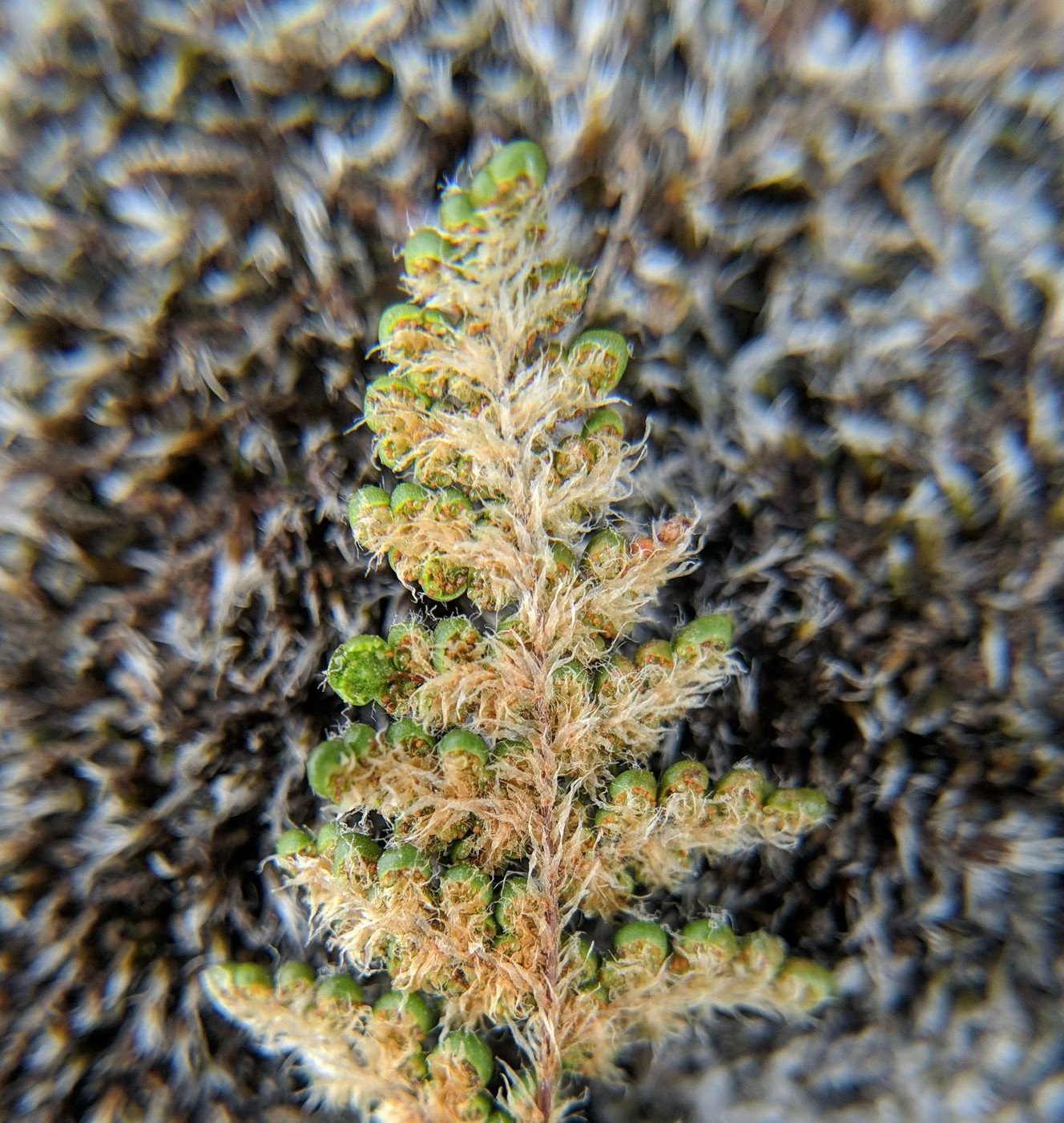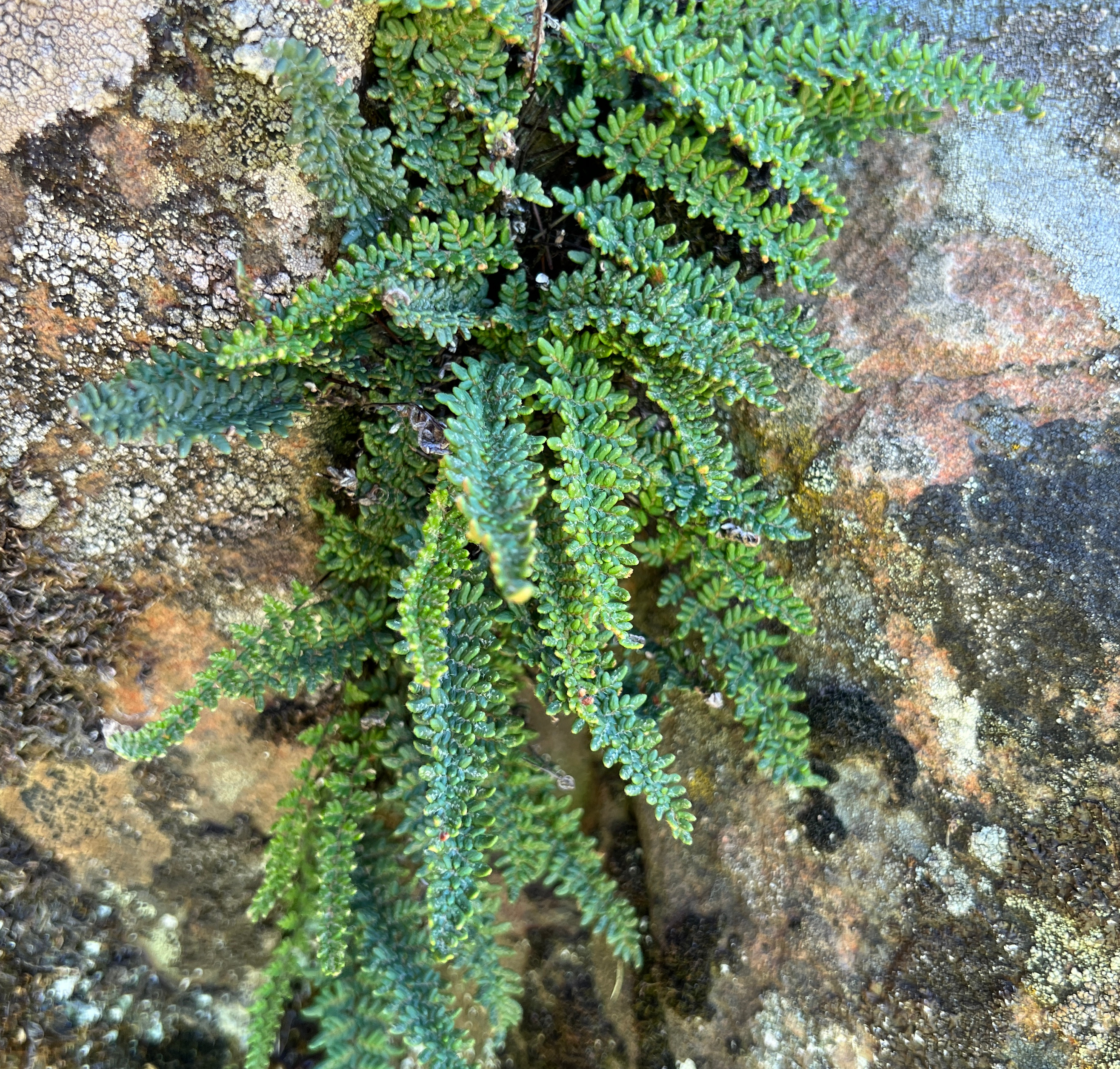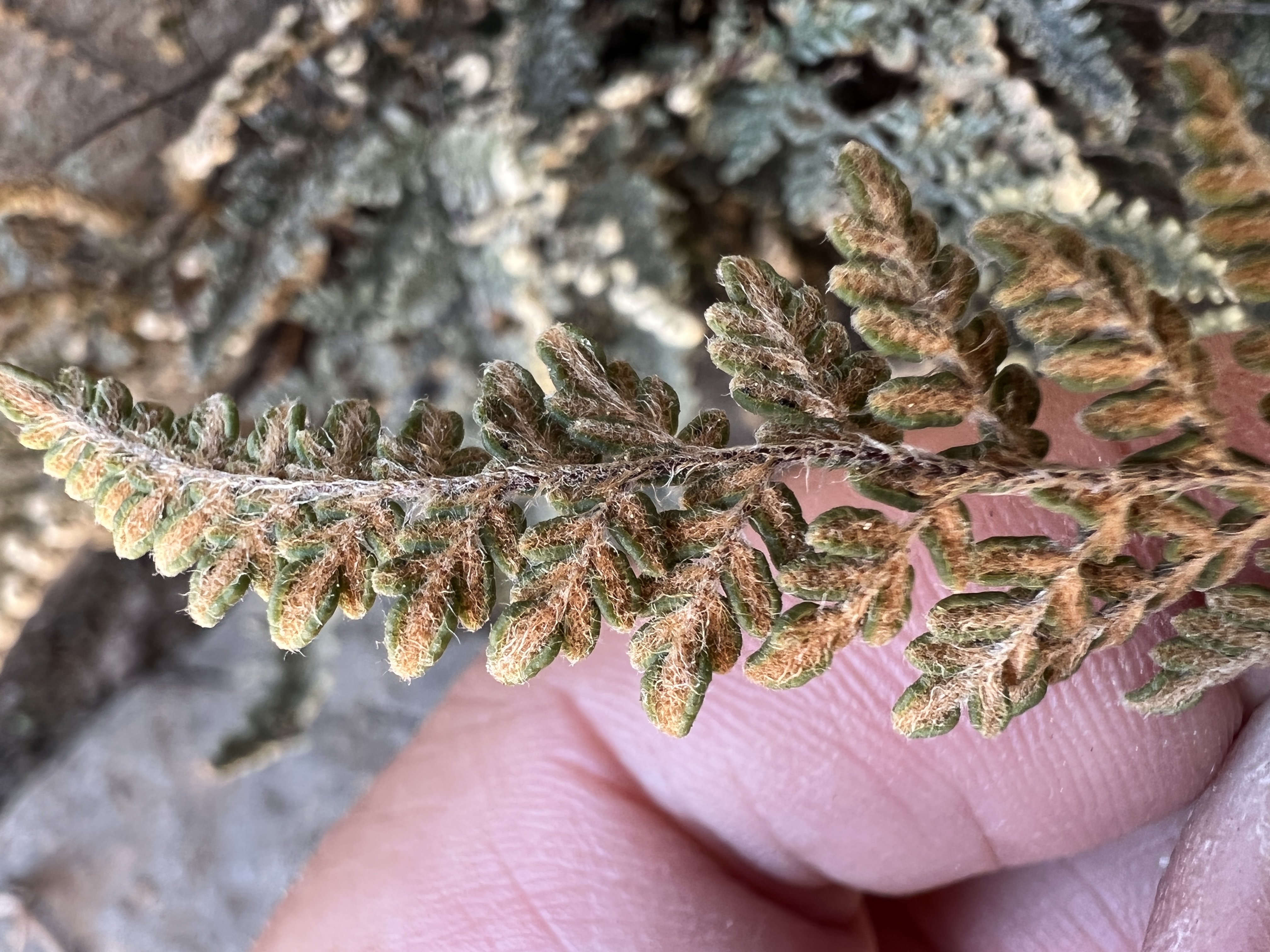|
Myriopteris Intertexta
''Myriopteris intertexta'', formerly ''Cheilanthes intertexta'', is a species of lip fern known by the common name coastal lip fern. It is native to montane California and western Nevada, Oregon east of the Cascades, and with a disjunct population in central Utah. It grows in dry rocky habitats in sun, typically in rock cracks with little or no soil. Description This fern produces clusters of dark green leaves up to about 25 centimeters long. Each leaf is divided into bumpy segments which are subdivided into pairs of rounded beadlike ultimate segments with their edges curled under to make them concave underneath. Each ultimate segment is less than 3 millimeters wide, sparsely hairy on top and scaly on the underside. Its sori are mostly hidden under the scales and curled leaflet margin (false indusium). The long-lanceolate scales on the underside of the leaflets are approximately 1 mm wide at their base, intermediate between those of its two parents ('' M. gracillima'' sc ... [...More Info...] [...Related Items...] OR: [Wikipedia] [Google] [Baidu] |
William Ralph Maxon
William Ralph Maxon, (February 27, 1877February 25, 1948) was an American botanist and pteridologist. He graduated from Syracuse University with a Bachelor of Philosophy, B.Ph. in biology, in 1898, and spent about one year at Columbia University doing post-graduate work on ferns with Lucien Marcus Underwood. In 1899 he accepted a position with the National Museum of Natural History, United States National Museum, which was a part of the Smithsonian Institution; he remained at the museum for his entire career. In 1899 he became an aide with the Division of Plants. He was named assistant curator in 1905, associate curator in 1914, and curator of that Division in 1937. He retired in 1946, but continued his association with the museum until his death in 1948. For the current version of this webpage, see . The later version does not indicate authorship. Alan Bain has written that, "Maxon specialized in the taxonomic study of Pteridophyta, especially those of tropical America, and was con ... [...More Info...] [...Related Items...] OR: [Wikipedia] [Google] [Baidu] |
Myriopteris Covillei
''Myriopteris covillei'', formerly known as ''Cheilanthes covillei'', is a species of cheilanthoid fern known by the common name Coville's lip fern. Coville's lip fern is native to the southwestern United States and Mexico. Description Leaf bases are closely spaced along the rhizome, which is typically in diameter. It is covered with persistent scales about long, which are linear to narrowly lanceolate, straight or slightly twisted, and tightly appressed (pressed against the surface of the rhizome). They are a uniform dark brown to black in color, or in some cases have paler, narrow margins of a light brown color, and lack marginal teeth. The fronds spring up in clusters; they do not unfold as fiddleheads like typical ferns (noncircinate vernation). When mature, they are long. The stipe (the stalk of the leaf below the blade) is long and less than wide, rounded on the upper surface, dark brown to dark reddish-brown in color. It is covered with white to red-brown, lance ... [...More Info...] [...Related Items...] OR: [Wikipedia] [Google] [Baidu] |
Flora Of The Sierra Nevada (United States)
Flora is all the plant life present in a particular region or time, generally the naturally occurring (indigenous) native plants. Sometimes bacteria and fungi are also referred to as flora, as in the terms ''gut flora'' or '' skin flora''. Etymology The word "flora" comes from the Latin name of Flora, the goddess of plants, flowers, and fertility in Roman mythology. The technical term "flora" is then derived from a metonymy of this goddess at the end of the sixteenth century. It was first used in poetry to denote the natural vegetation of an area, but soon also assumed the meaning of a work cataloguing such vegetation. Moreover, "Flora" was used to refer to the flowers of an artificial garden in the seventeenth century. The distinction between vegetation (the general appearance of a community) and flora (the taxonomic composition of a community) was first made by Jules Thurmann (1849). Prior to this, the two terms were used indiscriminately.Thurmann, J. (1849). ''Essai de Phy ... [...More Info...] [...Related Items...] OR: [Wikipedia] [Google] [Baidu] |
Flora Of Oregon
This is a list of plants by common name that are native to the U.S. state of Oregon. * Adobe parsley * Alaska blueberry * American wild carrot * Austin's popcornflower * Awned melic *Azalea * Azure penstemon * Baby blue eyes * Baldhip rose * Beach strawberry * Beach wormwood * Bearded lupine *Bensoniella *Bigleaf maple * Bigleaf sedge * Birdnest buckwheat * Birthroot, western trillium *Bitter cherry * Bleeding heart * Blow-wives * Blue elderberry *Bog Labrador tea * Bolander's lily * Bridges' cliffbreak * Brook wakerobin * Brown dogwood * Buckbrush * Bugle hedgenettle * Bunchberry * California broomrape * California buttercup * California canarygrass *California goldfields * California milkwort * California phacelia * California stoneseed *California wild rose * Camas * Canary violet * Canyon gooseberry * Cascara * Castle Lake bedstraw * Charming centaury * Chinese caps * Citrus fawn lily * Coastal cryptantha * Coastal sand-verbena * Coastal sneezeweed * Coastal woodfern * Co ... [...More Info...] [...Related Items...] OR: [Wikipedia] [Google] [Baidu] |
Flora Of Nevada
Flora is all the plant life present in a particular region or time, generally the naturally occurring (indigenous) native plants. Sometimes bacteria and fungi are also referred to as flora, as in the terms '' gut flora'' or '' skin flora''. Etymology The word "flora" comes from the Latin name of Flora, the goddess of plants, flowers, and fertility in Roman mythology. The technical term "flora" is then derived from a metonymy of this goddess at the end of the sixteenth century. It was first used in poetry to denote the natural vegetation of an area, but soon also assumed the meaning of a work cataloguing such vegetation. Moreover, "Flora" was used to refer to the flowers of an artificial garden in the seventeenth century. The distinction between vegetation (the general appearance of a community) and flora (the taxonomic composition of a community) was first made by Jules Thurmann (1849). Prior to this, the two terms were used indiscriminately.Thurmann, J. (1849). ''Essai de ... [...More Info...] [...Related Items...] OR: [Wikipedia] [Google] [Baidu] |
Ferns Of The United States
A fern (Polypodiopsida or Polypodiophyta ) is a member of a group of vascular plants (plants with xylem and phloem) that reproduce via spores and have neither seeds nor flowers. The polypodiophytes include all living pteridophytes except the lycopods, and differ from mosses and other bryophytes by being vascular, i.e., having specialized tissues that conduct water and nutrients and in having life cycles in which the branched sporophyte is the dominant phase. Ferns have complex leaves called megaphylls, that are more complex than the microphylls of clubmosses. Most ferns are leptosporangiate ferns. They produce coiled fiddleheads that uncoil and expand into fronds. The group includes about 10,560 known extant species. Ferns are defined here in the broad sense, being all of the Polypodiopsida, comprising both the leptosporangiate ( Polypodiidae) and eusporangiate ferns, the latter group including horsetails, whisk ferns, marattioid ferns, and ophioglossoid f ... [...More Info...] [...Related Items...] OR: [Wikipedia] [Google] [Baidu] |
Ferns Of California
A fern (Polypodiopsida or Polypodiophyta ) is a member of a group of vascular plants (plants with xylem and phloem) that reproduce via spores and have neither seeds nor flowers. The polypodiophytes include all living pteridophytes except the lycopods, and differ from mosses and other bryophytes by being vascular, i.e., having specialized tissues that conduct water and nutrients and in having life cycles in which the branched sporophyte is the dominant phase. Ferns have complex leaves called megaphylls, that are more complex than the microphylls of clubmosses. Most ferns are leptosporangiate ferns. They produce coiled fiddleheads that uncoil and expand into fronds. The group includes about 10,560 known extant species. Ferns are defined here in the broad sense, being all of the Polypodiopsida, comprising both the leptosporangiate (Polypodiidae) and eusporangiate ferns, the latter group including horsetails, whisk ferns, marattioid ferns, and ophioglossoid ferns. Ferns f ... [...More Info...] [...Related Items...] OR: [Wikipedia] [Google] [Baidu] |
Hybrid (biology)
In biology, a hybrid is the offspring resulting from combining the qualities of two organisms of different breeds, varieties, species or genera through sexual reproduction. Hybrids are not always intermediates between their parents (such as in blending inheritance), but can show hybrid vigor, sometimes growing larger or taller than either parent. The concept of a hybrid is interpreted differently in animal and plant breeding, where there is interest in the individual parentage. In genetics, attention is focused on the numbers of chromosomes. In taxonomy, a key question is how closely related the parent species are. Species are reproductively isolated by strong barriers to hybridisation, which include genetic and morphological differences, differing times of fertility, mating behaviors and cues, and physiological rejection of sperm cells or the developing embryo. Some act before fertilization and others after it. Similar barriers exist in plants, with differences in flowering tim ... [...More Info...] [...Related Items...] OR: [Wikipedia] [Google] [Baidu] |
Allotetraploid
Polyploidy is a condition in which the cells of an organism have more than one pair of ( homologous) chromosomes. Most species whose cells have nuclei (eukaryotes) are diploid, meaning they have two sets of chromosomes, where each set contains one or more chromosomes and comes from each of two parents, resulting in pairs of homologous chromosomes between sets. However, some organisms are polyploid. Polyploidy is especially common in plants. Most eukaryotes have diploid somatic cells, but produce haploid gametes (eggs and sperm) by meiosis. A monoploid has only one set of chromosomes, and the term is usually only applied to cells or organisms that are normally diploid. Males of bees and other Hymenoptera, for example, are monoploid. Unlike animals, plants and multicellular algae have life cycles with two alternating multicellular generations. The gametophyte generation is haploid, and produces gametes by mitosis, the sporophyte generation is diploid and produces spores by meiosis ... [...More Info...] [...Related Items...] OR: [Wikipedia] [Google] [Baidu] |
Myriopteris Intertexta McNitt 191313489
''Myriopteris'', commonly known as the lip ferns, is a genus of cheilanthoid ferns. Like other cheilanthoids, they are ferns of dry habitats, reproducing both sexually and apogamously. Many species have leaves divided into a large number of small, bead-like segments, the probable inspiration for the generic name. Hairs and/or scales are often present on both the upper and lower surfaces of the leaf, and their presence and appearance are useful in distinguishing between species. The genus is most diverse in Mexico, but species are found from southwestern Canada south to southern Chile, and one species is endemic to southern Africa. Description No single morphological character divides ''Myriopteris'', as presently circumscribed, from the other cheilanthoids. Convergent evolution in arid environments is thought to be responsible for widespread homoplasy in the morphological characters traditionally used to classify this group. While small, bead-like ultimate segments are associat ... [...More Info...] [...Related Items...] OR: [Wikipedia] [Google] [Baidu] |
Myriopteris Gracillima
''Myriopteris gracillima'', formerly known as ''Cheilanthes gracillima'', is a species of lip fern known by the common name lace lip fern. It is native to western North America, where it grows in rocky habitat from British Columbia to California to Montana. Hitchcock, C.L. and Cronquist, A. 2018. Flora of the Pacific Northwest, 2nd Edition, p. 56. University of Washington Press, Seattle. Description ''Myriopteris gracillima'' is a small fern with dark green leaves up to about long that arise from a short creeping ground stem (rhizome), such that plants often have an elongated base, for example creeping along a rock crevice. Each frond is intricately divided into segments made up of pairs of smaller segments which are oval in shape and oblong beadlike, with their edges rolled under, giving it a somewhat succulent appearance. They are also quite hairy and scaly, mostly on the underside of the leaf and leaf mid-rib. The sori are located within rolled-under margins (false i ... [...More Info...] [...Related Items...] OR: [Wikipedia] [Google] [Baidu] |
Michael D
Michael D may refer to: * Mike D (born 1965), founding member of the Beastie Boys Arts * Michael D. Cohen (actor) (born 1975), Canadian actor * Michael D. Ellison, African American recording artist * Michael D. Fay, American war artist * Michael D. Ford (1928–2018), English set decorator * Michael D. Roberts, American actor Business * Michael D. Dingman (1931–2017), American businessman * Michael D. Ercolino (1906–1982), American businessman * Michael D. Fascitelli, (born c. 1957), American businessman * Michael D. Penner (born 1969), Canadian lawyer and businessman Education * Michael D. Aeschliman (born 1948), American–Swiss educator * Michael D. Cohen (academic) (1945–2013), professor of complex systems, information and public policy at the University of Michigan * Michael D. Hanes, American music educator * Michael D. Hurley (born 1976), British Professor of Literature and Theology * Michael D. Johnson, a former President of John Carroll University * Mic ... [...More Info...] [...Related Items...] OR: [Wikipedia] [Google] [Baidu] |







